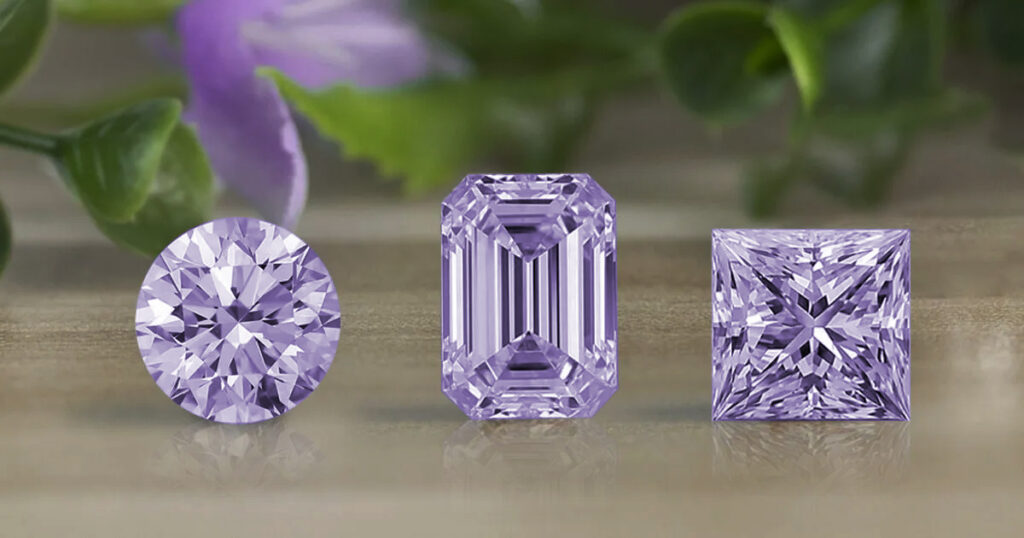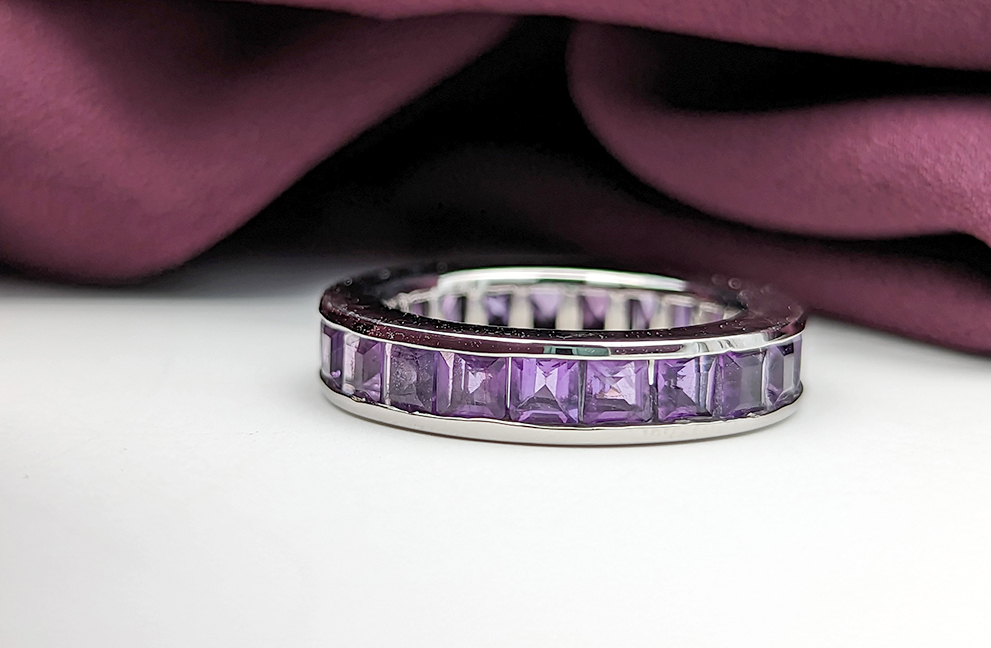Purple Color Diamonds
Purple color diamonds are among the rarest colored diamonds, known for their enchanting hues ranging from lavender to deep plum. Their scarcity and unique beauty make them an attractive option for jewelers looking to offer exclusive high end pieces that stand out in the market trend.
Purple Diamonds
Purple diamonds are among the rarest and most captivating gemstones in the world of fancy color diamonds, prized for their unique and mesmerizing hue. These enchanting stones range from fancy light purple to fancy deep purple, often exhibiting secondary hues of pink or blue that add to their allure. Natural purple diamonds are exceptionally scarce, making them highly sought after by collectors and connoisseurs alike. However, the advent of lab grown purple diamonds has made these stunning gems more accessible to a wider audience with more options, offering the same visual appeal and physical properties as their natural counterparts.

What are Purple Lab Grown Diamonds?
Purple Lab Diamonds are synthetic diamonds created in controlled laboratory environments that exhibit a distinct purple hue. These man made diamonds possess the same physical, chemical, and optical properties as one natural purple colour diamond, but are produced through advanced technological processes rather than formed over millions of years in the earth. The purple coloration in these lab grown diamonds is achieved through careful manipulation of growth conditions and the introduction of specific elements during the diamond synthesis process. While the exact mechanisms are proprietary, the presence of hydrogen and potential crystal lattice deformations are thought to contribute to the purple hue.
What causes a purple stone to be purple?
The formation of colored diamonds, including purple ones, is a fascinating process that involves the interplay of carbon atoms and trace impurities within the diamond’s crystal structure. Here’s a more refined explanation of this phenomenon:
Diamonds are primarily composed of carbon atoms arranged in a specific crystalline structure. However, the presence of trace elements or impurities can significantly influence a diamond’s color. These impurities can become trapped within the crystal lattice during the diamond’s formation, altering its light absorption and reflection properties.
In some cases, these impurity atoms can substitute for carbon atoms within the crystal matrix. This atomic substitution occurs in a highly ordered and precise manner, maintaining the diamond’s overall structural integrity. Remarkably, this process preserves the transparency of three external planes of the diamond, which is why we can still see through colored diamonds.
For purple diamonds specifically, the color is believed to be caused by the presence of hydrogen during formation. In some instances, chromium atoms may replace nitrogen atoms in the crystal structure, contributing to the purple hue. This substitution, along with potential plastic deformation of the crystal lattice, results in the unique and captivating purple color that makes these diamonds so rare and valuable.
Purple Color Shades Available In Lab Grown

Fancy Light Purple Diamond
Fancy Light Purple diamonds exhibit a soft, pastel-like purple hue. These diamonds have a subtle yet noticeable purple color that is lighter in intensity compared to other grades. They offer a delicate and elegant appearance, making them ideal for those who prefer a more understated look.
Fancy Purple Diamond
The Fancy Purple grade represents a step up in color intensity from Fancy Light. These diamonds display a more pronounced purple hue visible to the naked eye. They strike a balance between subtlety and vibrancy, making them versatile for various jewelry designs.
Fancy Intense Purple Diamond
Fancy Intense Purple diamonds showcase a deeper and more saturated purple color. The intensity is stronger than Fancy Purple, creating a more vivid and eye-catching appearance. These diamonds are highly sought after for their rich color and striking visual impact.
Fancy Vivid Purple Diamond
Fancy Vivid Purple represents one of the most desirable and rare color grades for purple diamonds. These stones exhibit an exceptionally strong and pure purple hue with maximum color saturation. The vivid intensity creates a breathtaking visual effect, making these diamonds particularly valuable and prized by collectors.
Fancy Deep Purple Diamond
Fancy Deep Purple diamonds are characterized by their dark, rich purple color. While not as bright as Fancy Vivid, these diamonds have a profound depth to their color that can appear almost mysterious. The deep purple hue is often described as regal and sophisticated, appealing to those who prefer a more intense and dramatic look.
Purple Diamond Jewelry

Purple diamond jewelry
Purple Diamond Jewelry has become increasingly popular among those seeking unique and captivating pieces. The allure of these rare-colored diamonds has led to their incorporation in various jewelry designs, offering a distinctive alternative to traditional colorless diamonds.
Purple Diamond Rings
Purple diamond rings are a stunning choice for those who want to make a bold statement. These rings can feature a solitaire purple diamond as the centerpiece or incorporate smaller purple diamonds in intricate designs. The purple hue adds a touch of royalty and mystique to any ring setting, whether it’s a classic band or a more elaborate design.
Purple Diamond Engagement Rings
For couples looking for a non-traditional engagement ring, a purple diamond engagement ring offers a romantic and unique option. These rings symbolize passion and creativity, making them perfect for those who want their love story to stand out. Purple diamond engagement rings can be designed with a single purple diamond as the focal point or accented with colorless diamonds for added sparkle.
Purple Diamond Wedding Rings
Purple diamond wedding rings are gaining popularity among couples who want to celebrate their union with a touch of elegance and individuality. These rings can be crafted to match purple diamond engagement rings or designed as standalone pieces. The deep purple hue symbolizes devotion and can be incorporated into various band styles, from simple to ornate.
Purple Diamond Necklaces
Purple diamond necklaces magical look that draws attention to the neckline. These necklaces can range from delicate pendants featuring a single purple diamond to elaborate designs with multiple stones. A purple diamond necklace can be a versatile addition to any jewelry collection, suitable for both formal events and everyday wear.
Purple Diamond Earrings
Purple diamond earrings offer a subtle yet striking way to incorporate these rare gems into your jewelry wardrobe. From classic studs to dramatic chandelier designs, purple diamond earrings can complement a wide range of styles and occasions. They can be paired with other purple diamond jewelry pieces for a coordinated look or worn as a standalone statement.
Purple Diamond Price
Purple diamond prices vary significantly based on several factors, including color intensity, size, clarity, and overall rarity. As one of the rarest diamond colors, purple diamonds command premium prices in the market. Natural purple diamonds, especially those with vivid or intense hues, can fetch prices ranging from $10,000 to $25,000 per carat for smaller stones (under 0.5 carats) with medium clarity grades. For larger stones or those with higher color intensity, prices can quickly escalate to $50,000 per carat or more. Exceptionally rare, large, and high-quality purple diamonds have been known to sell for millions of dollars per carat at auction.
However, lab grown purple diamonds offer a more affordable alternative, with prices starting around $4,400 per carat, though this can vary based on the stone’s characteristics.
